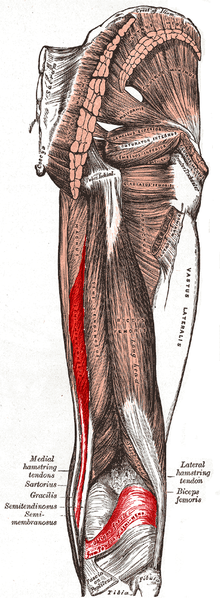Description
Semimembranosis is one of a group of muscles called the Hamstrings. It is located on the posteromedial side of the thigh deep to Semitendinosus. Its origin is the ischial tuberosity on the inferior pelvis and the insertion is the medial tibial condyle. It’s primary action is knee flexion, hip extension and knee internal rotation.[1][2]
In the lower part of the thigh, semitendinosus and semimembranosus together form the upper medial boundary of the popliteal fossa.[2]
Origin
A strong membranous tendon attaches to the upper lateral facet on the rough part of the ischial tuberosity.[1]
Insertion
An aponeurotic tendon arises at the distal end of the semimembranosus where it narrows and attaches to a horizontal groove on the posteromedial surface of the medial tibial condyle. The tendon then passes upwards and laterally to form the oblique popliteal ligament.[1]
A bursae separate the muscle from the medial head of the tibia and the medial head of the Gastrocnemius[1]
Nerve
Tibial division of the Sciatic Nerve (root value L5, S1 and 2).[1]
Nerve supply for the skin covering the muscle is L2.[1]
Artery
Branches from the internal iliac, popliteal, and profunda femoris arteries.[2]
Function
Gracilis, Sartorius, Popliteus, gastrocnemius, and plantaris assist with flexion of the knee.
- Knee internal rotation of the knee when it is flexed
- Agonists: popliteus and semitendinosus
- Antagonists: biceps femoris (long head) and biceps femoris (short head)
- Sartorius and Gracilis assist with internal rotation of the knee when the knee is flexed.
Functional movements
- Stand from sitting
- Walking upstairs
- Standing jump forwards
- Standing jump upwards
Clinical relevance
Hamstring Syndrome
This pathology commonly affects athletes who present with localised pain near the ischial tuberosity. The pathophysiology is thought to be that of an insertional tendopathy at the ischium but there may also be involvement of sciatic nerve compression. The pain in hamstring syndrome radiates down the posterior thigh or popliteal region and is exacerbated when the hamstrings are on tension. This is often seen in sprinters or hurdlers. On examination there is exquisite tenderness over the ischial tuberosity and percussion in that region may reproduce the sciatic distribution of pain. Treatment involves rest, anti-inflammatory agents and steroid injections. [2]
Baker’s cyst
The bursae that separates the muscle from the medial head of the tibia and the medial head of the Gastrocnemius may at times become enlarged with distended fluid. This swelling is termed ‘Baker’s cyst’ (described by Morrant Baker in the 19th century as a cystic mass in the popliteal fossae of children).[2]
Assessment
Palpation
Semimembranous lies deep to semitendinosus and is difficult to palpate, but can be felt easier when the knee is flexed.[2]
Length
Straight leg raise[3]
The patient is positioned in supine with the hip and knee extended. One hand is placed over the anterior thigh to maintain full extension throughout the movement. The hip is flexed until firm muscular resistance to further motion is felt. A goniometer can then be aligned as follows:
- Stationary arm: Lateral midline of trunk
- Axis: Greater trochanter of the femur
- Moving arm: Lateral epicondyle of femur
Maximal hip flexion can then be documented.
Knee extension test[3]
The patient is positioned in supine with the hip to 90o and the contralateral limb should be placed on a supporting surface with the knee extended. The knee is then extended through full range of motion whilst the hip is maintained in 90o flexion.
- Active test: the patient performs active knee extension of the knee until myoclonus is observed in the hamstring
- Passive test: the knee is passively extended until firm muscular resistance to further motion is felt
A goniometer can then be aligned as follows:
- Stationary arm: Greater trochanter of femur
- Axis: Lateral epicondyle of femur
- Moving arm: Lateral malleolus
Maximal knee extension can be documented.
Treatment
Resources
- ↑ 1.01.11.21.31.41.5 Palastanga N, Field D, Soames R. Anatomy and human movement: structure and function. Elsevier Health Sciences; 2012.
- ↑ 2.02.12.22.32.42.5 Anatomy.tv | 3D Human Anatomy | Primal Pictures [Internet]. Anatomy.tv. 2018 [cited 30 April 2018]. Available from: http://www.anatomy.tv/
- ↑ 3.03.1 Reese NB, Bandy WD. Joint Range of Motion and Muscle Length Testing-E-Book. Elsevier Health Sciences; 2016 Mar 31.


